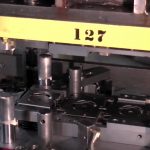How Does Robotic Process Automation Work?
The Digital Workforce: The Future is Now
Robotic Process Automation (RPA) may sound like something out of a sci-fi movie; however, it is very much a part of present-day business processes for companies who want to get their product or service to market faster, with higher efficiency, and at a lower cost. Industries around the globe are continually implementing this rapidly evolving technology to their business processes as the scope of automation continually expands at a rapidly growing rate. According to HfS Research, the global market for RPA software and services reached $271 million in 2016, and is expected to grow to $1.2 billion by 2021 at a compound annual growth rate of 36% [1].
However, what is robotic process automation and how does it work? Simply put, responsive software robots imitate the physical actions of humans by carrying out repetitive low-value tasks by following a set of defined rules. A digital workforce is designed to take away repetitive steps in the operations process that human employees would otherwise have to do. Some of these tasks include, processing transactions, data collecting and data entry, cross-referencing invoices, sending bulk emails to customers, and other manual, high-volume tasks. Having responsive software robots take over these monotonous jobs frees up employees to focus on more essential, higher value operations in the organization.
Fast-Track Productivity, Reduce Expenses
Industries such as telecom, banking, and manufacturing to insurance, transportation, and logistics are experiencing the significant benefits of RPA. From faster turnaround time, higher quality, and lower costs, these agile software robots effectively communicate with business systems and applications, streamlining processes without the need for complex code. Moreover, unlike humans, robots boast a 100% data accuracy rate. This statistic is a significant win for businesses who want to sustain a highly efficient, error-free operation. In addition to the staggering precision rates between humans and software automation robots, a digital workforce can handle a multitude of monotonous jobs with supreme speed, with little or no downtime.
Implementing robotic process automation can significantly ramp up productivity while reducing costs throughout an organization. This process, coupled with the fact that software robots can work seven days a week, around the clock, for indefinite periods of time means an operation does not have to stop because an employee is away on vacation or out sick.
Greater Compliance and Control
Another great benefit of robotic process automation is the ability to maintain better oversight and internal control when it comes to compliance. Financial organizations such as banks, for example, are continuously faced with stricter regulatory compliance standards. Robotic process automation, which performs a process function in precisely the same way each time, can assist financial institutions as well as industries across the board with more effective and robust compliance strategies. If an audit were to occur, RPA enables companies to produce an audit log of activity that can be reviewed at any time.
Non-Invasive Robotic Automation Platform
Implementing a non-invasive, non-disruptive robotic automation platform that is complementary to a company’s main business systems means changes to the existing IT infrastructure are unnecessary. Having the ability to build, implement, and oversee software robots without the need for expensive, complex coding allows an organization to be operational in a matter of days or weeks—not several months.
Scalability is also essential when it comes to robotic process automation. It is vital for company leaders to think about not only what their organization’s current needs are, but what their anticipated needs may be in the future. A prime question that must be asked from the get-go is what the organization’s objectives are? Taking a closer look at the business processes and accessing if its operations would benefit from robotic process automation is the first step. As a company grows and their requirements change, scalability becomes more critical.
Working Alongside The Digital Workforce
The intended purpose of robotic process automation is not about replacing employees; instead, it is having employees work smarter in tasks where they can provide a better customer journey through meaningful engagement. Back and mid-office processes are where robotic automation software can be most beneficial to a company’s business processes.
Finally, it is important to remember that human employees need to work in collaboration with their digital counterparts. Therefore, it is imperative that employees be trained and made to feel comfortable with this new technology. Thus, keeping robotic process automation simple and then adding in more complex businesses processes in stages as the technology is learned, will help facilitate an organization’s ultimate goal of bringing productivity and efficiency to a higher level.
Author Bio:
Paul Johndrow is Owner and Vice President of Marketing and Sales at All Star Software Systems, a Connecticut-based systems integrator that sells, implements and supports multiple products as a solution. Since 2002, he has built his company’s departments around solution specialization and strong technical product knowledge. A former United States Air Force non-commissioned officer, Paul holds a degree in Electronics Engineering from the New England Institute of Technology.
Sources:
- https://www.horsesforsources.com/RPA-marketsize-HfS_061017
- https://www.kofax.com/Products/Robotic-Process-Automation
- https://www.kofax.com/Products/Robotic-Process-Automation/Kapow/Overview















